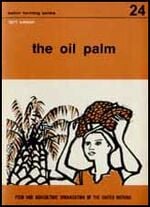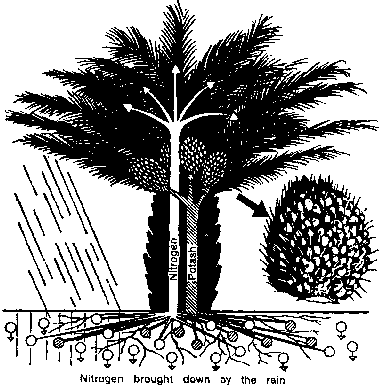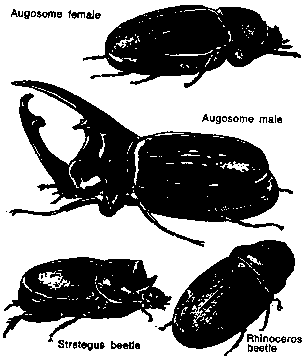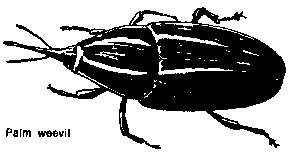36. Cultivation
You must remove the weeds around the young oil palms. This work is done with a hoe or a machete.
During the first year, cultivate 6 times.
Remove all the weeds for 2 metres around each stem. During the first months, the weeds between rows have to be cut.
If you leave the weeds, the cover crop will not grow well.
37. Trimming the plants
You must always cut away the dry leaves of the oil palm.
In order to cut the leaves without damage to the oil palm, your tools must be well sharpened.
Cut the leaves very close to the stem, so that no other plants can grow in the axil of the cut-off leaves.
Remove from the trunk any plants (ferns) that may grow in the axils of the leaves. Remove also the male flowers.
38. Applying fertilizer
The oil palm needs a lot of mineral salts to form its leaves and fruit clusters. When the oil palm is young, it needs above all nitrogen.
When the oil palm has begun to produce, it needs a lot of potash. Potash increases the number of fruit clusters, and makes them bigger.
Nitrogen brought down by the rain
How much fertilizer to apply[edit | edit source]
Example: Ivory Coast
On plantations (per tree per year)
|
Savanna |
Forest | |||
|
Grammes |
Fertilizer |
Grammes |
Fertilizer | |
|
Year of planting |
500 |
Ammonium sulfate |
250 |
Ammonium sulfate |
|
500 |
Potassium chloride |
250 |
Potassium chloride | |
|
1 year |
750 |
Ammonium sulfate |
500 |
Ammonium sulfate |
|
750 |
Potassium chloride |
300 |
Potassium chloride | |
|
2 years |
750 |
Ammonium sulfate |
750 |
|
|
750 |
Potassium chloride |
to 1500 |
Potassium chloride | |
|
3 and 4 years and afterwards |
1000 |
750 |
||
|
to 1500 |
Potassium chloride |
to 1500 |
Potassium chloride | |
On natural palm groves (per tree per year): 1000 grammes of potsassium chloride
Example: Benin
On plantations (per tree per year)
|
Age of oil palm |
Ammonium sulfate |
Potassium chloride |
|
Grammes |
Grammes | |
|
Year of planting |
250 |
200 |
|
1 year |
350 |
200 |
|
2 years |
500 |
500 |
|
3 years |
600 |
750 |
|
4 years |
600 |
1000 |
Protect against insects[edit | edit source]
39. Rhinoceros and augsome beetles Strategus beetle
To protect the young trees, put in the axil of the leaves a mixture of sawdust and BHC.
Insects
Palm weevil (Rhynchophora)
To avoid dangerous attacks, be very careful not to wound the trees. The insects may lay their eggs in the wounds of the oil palm.
There are other insects, but it is difficult for the grower to control them.
Palm weevil
Oil palms may also be attacked by rate and agoutis.
Rats and agoutis can eat young oil palms. Protect your young oil palms against agoutis by wire netting round each tree. As a protection against rats, you can place little bags with poisoned mane near the oil palms.
Diseases
Oil palms may be attacked by several diseases. If you see distorted leaves or leaves that break, ask for advice from the extension service.



